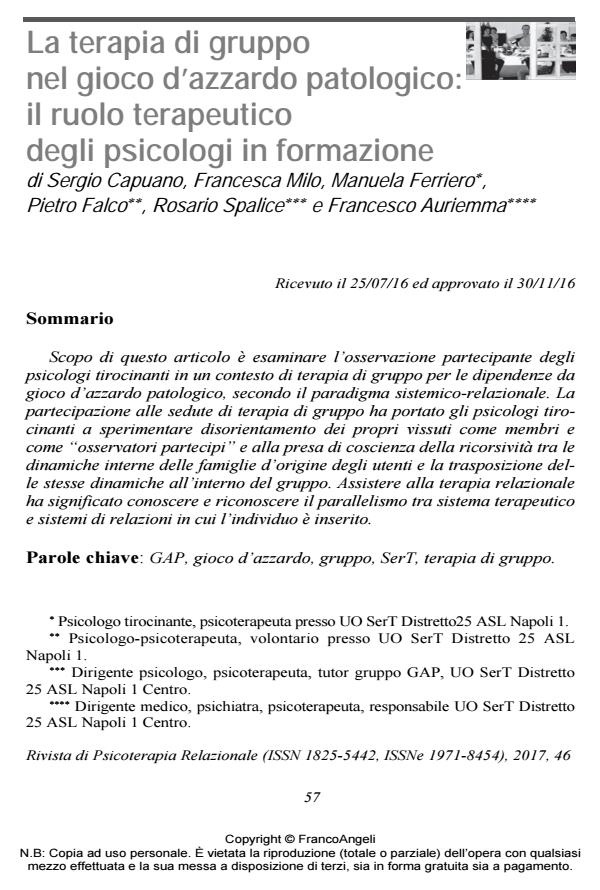Systemic-relational paradigm and therapy group: the point of view of psychologist trainees
Journal title RIVISTA DI PSICOTERAPIA RELAZIONALE
Author/s Sergio Capuano, Francesca Milo, Manuela Ferriero, Pietro Falco, Rosario Spalice, Francesco Auriemma
Publishing Year 2017 Issue 2017/46
Language Italian Pages 15 P. 57-71 File size 194 KB
DOI 10.3280/PR2017-046005
DOI is like a bar code for intellectual property: to have more infomation
click here
Below, you can see the article first page
If you want to buy this article in PDF format, you can do it, following the instructions to buy download credits

FrancoAngeli is member of Publishers International Linking Association, Inc (PILA), a not-for-profit association which run the CrossRef service enabling links to and from online scholarly content.
The aim of this article is to show the observation of trainee psychologists participating in group therapy context for addiction to pathological gambling according to systemic-relational paradigm. Participation in sessions of group therapy led to experience disorientation of one’s experiences as members and as partecipant observers and awareness of recursion between the internal dynamics of the families of origin of user transposition of the same dynamics in the group. Witness the relational therapy, it meant knowing and recognizing the parallels between therapy system and the systems of relations in which the individual is inserted.
Keywords: GAP, gambling, group, SerT, group therapy.
- Baldascini L. (2002). Legami terapeutici. Il terapeuta della famiglia nella psicoterapia individuale-sistemica. Milano: FrancoAngeli.
- Bowen M. (1977). Principi e tecniche di terapia familiare multipla. Terapia Familiare, 1.
- Bowen M. (1980). Dalla famiglia all’individuo. La differenziazione del sé nel sistema familiare. Roma: Astrolabio Ubaldini.
- Carrieri M. (2009). Il gioco patologico. Fasi del gioco d’azzardo patologico. Home Rivista, 3.
- Cirillo S., Berrini R., Cambiaso G., Mazza R. (1996). La famiglia del tossicodipendente. Milano: Raffaello Cortina.
- Custer R.L. (1984). Profile of the pathological gambler. Journal of Clinical Psychiatry, 45(12): 35-8.
- Hinshelwood R.D. (1989). Cosa accade nei gruppi. Milano: Raffaello Cortina.
- Rosenthal R.J. (1987). The psychodinamic of pathological gambling: a review of the literature. In: Galski T. (ed.), The Handbook of pathological gambling, Springfield: Charles C. Thomas Publisher.
- Rotondo G. (1982). Il gatto e la volpe: un modello di coterapia. Terapia Familiare, 11.
- Serpelloni G., Rimondo C. (2012). Gioco d’azzardo problematico e patologico: inquadramento generale, meccanismi fisiopatologici, vulnerabilità, evidenze scientifiche per la prevenzione, cura e riabilitazione. Italian Journal on Addiction, 2, 3-4: 7-44.
- Strom P., Trasarti Sponti W. (2006). La coterapia didatta-allievo: tra apprendimento e cambiamento. In: Ugazio V., Defilippi P.G., Schepisi L., Solfaroli Camillocci D., a cura di, Famiglie, gruppi e individui. Le molteplici forme della psicoterapia sistemico-relazionale. Milano: FrancoAngeli.
- Whitaker C.A. (1978). Coterapia di un caso di schizofrenia cronica. Terapia Familiare, 3.
- Yalom I. (1997). Teoria e Pratica della Psicoterapia di Gruppo. Torino: Bollati Boringhieri.
Sergio Capuano, Francesca Milo, Manuela Ferriero, Pietro Falco, Rosario Spalice, Francesco Auriemma, La terapia di gruppo nel gioco d’azzardo patologico: il ruolo terapeutico degli psicologi in formazione in "RIVISTA DI PSICOTERAPIA RELAZIONALE " 46/2017, pp 57-71, DOI: 10.3280/PR2017-046005